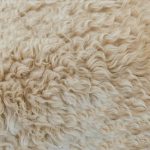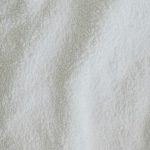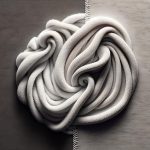When working with French terry fabric, you'll quickly realize that its unique characteristics can significantly impact the fit and shape retention of your garments. The plush pile adds bulk and texture, requiring adjustments to seam allowances and pattern pieces. But that's just the beginning – the fabric's density and stretch ratio also play a crucial role in determining the garment's overall shape and drape. As you start to work with French terry, you'll likely notice that it can be prone to stretching or sagging in certain areas. But what can you do to minimize these effects and achieve a great fit?
Table of Contents
Characteristics of French Terry Fabric
When working with French terry fabric, you're likely to notice its unique characteristics, including a soft, plush pile on one side and a smooth surface on the other, which can affect the fit of your garment.
This type of fabric is known for its absorbency, making it perfect for activewear and loungewear. The plush pile side is often used as the outer layer, while the smooth side is used as the inner layer, providing a comfortable surface against the skin.
You'll also notice that French terry fabric has a bit of stretch to it, making it a great choice for garments that require flexibility.
The fabric's density can vary, with some French terry fabrics being heavier and more durable than others. When selecting a French terry fabric, consider the intended use of the garment and choose a fabric that suits your needs.
Additionally, French terry fabric can be prone to pilling, so it's essential to follow proper care instructions to extend the life of your garment. By understanding the characteristics of French terry fabric, you can make informed decisions when working with this unique textile.
How French Terry Affects Fit
The unique characteristics of French terry fabric, particularly its plush pile and varying density, can significantly impact the fit of your garment, requiring you to make adjustments to your pattern or sewing technique to achieve the desired silhouette. When working with French terry, you'll need to consider how the fabric's thickness and texture will affect the overall fit of your garment.
Here's a comparison of how French terry's characteristics can impact fit:
| Characteristic | Impact on Fit |
|---|---|
| Plush pile | Adds bulk and texture, requiring adjustments to seam allowances and pattern pieces |
| Varying density | Can cause fabric to stretch or sag, affecting the garment's overall shape and drape |
| Thickness | Can make garments appear more voluminous, requiring adjustments to pattern pieces and seam allowances |
To achieve a flattering fit, you may need to adjust your pattern or sewing technique to accommodate French terry's unique characteristics. This might involve using a larger seam allowance, adjusting the grain line, or using a walking foot to help guide the fabric as you sew. By understanding how French terry affects fit, you can make informed adjustments to create a garment that looks and feels great.
Factors Affecting Shape Retention
When you're working with French Terry, you'll notice that its shape retention is influenced by several key factors.
You'll want to consider the material's weave patterns, as they can significantly impact how well the fabric holds its shape over time.
Additionally, you'll need to think about the fabric's stretch levels, as they can also affect how well the garment retains its original shape.
Material Weave Patterns
The density and pattern of a French terry fabric's weave significantly impact its ability to retain shape, with tighter weaves generally providing better resistance to shrinkage and distortion. The way the fibers are woven together can either enhance or compromise the fabric's dimensional stability. When choosing a French terry fabric for your garment, consider the weave pattern and its potential impact on the final product.
- Tighter weaves: Provide better resistance to shrinkage and distortion, but may be less breathable and more prone to pilling.
- Twill weave: Creates a diagonal ribbing that can enhance the fabric's durability and resistance to distortion.
Fabric Stretch Levels
Most French terry fabrics exhibit some degree of stretch, which can significantly impact the garment's fit and shape retention, and understanding the factors that influence this stretch is crucial for achieving the desired level of comfort and durability.
As you work with French terry, you'll notice that the fabric's stretch level can vary greatly depending on the type of fibers used, the weave pattern, and the finishing treatments applied.
You'll typically find that French terry fabrics with a higher percentage of elastane or spandex will have a greater degree of stretch. This is because these fibers are designed to provide elasticity and recovery.
On the other hand, fabrics with a higher percentage of cotton or other natural fibers will tend to have less stretch.
You'll also notice that the weave pattern can affect the fabric's stretch level, with tighter weaves generally having less stretch than looser weaves.
Minimizing Shrinkage and Distortion
To minimize shrinkage and distortion in French terry garments, it's essential to consider the fabric's unique properties and handling requirements from the design stage onwards. You'll want to take into account the fabric's natural shrinkage rate, which can range from 3-5% depending on the cotton content and weave. To mitigate this, you can use techniques such as pre-shrinking the fabric before cutting, or using a shrinkage allowance in your pattern making.
- Pre-wash and dry the fabric: Before cutting, wash and dry the fabric to pre-shrink it and remove any excess dye or finishes that may affect the garment's fit.
- Use a shrinkage allowance: Factor in a shrinkage allowance when creating your patterns to ensure a accurate fit after the garment has been washed and dried.
- Avoid over-drying: French terry can shrink excessively if it's over-dried, so remove it from the dryer while it's still slightly damp to prevent distortion.
Design Considerations for French Terry
When designing garments with French terry, you'll want to consider a few key factors to ensure a great fit.
First, you'll need to select a fabric weight that suits your design, taking into account the level of drape and structure you want to achieve.
Fabric Weight Selection
You'll typically choose from three fabric weight options for French terry garments: lightweight (8-10 oz), mid-weight (12-14 oz), or heavyweight (16-18 oz), each affecting the overall fit and drape of the garment. When selecting a fabric weight, consider the intended use and desired look of the garment. For example, a lightweight French terry is perfect for warm-weather tops or loungewear, while a heavyweight option is better suited for colder climates or outerwear.
- Drape and flow: Lighter weights will have a softer, more fluid drape, while heavier weights will have a more structured, rigid drape.
- Warmth and insulation: Heavier weights will provide more warmth and insulation, making them ideal for colder climates.
- Durability and longevity: Heavier weights are generally more durable and less prone to pilling or snagging.
Stretch Ratio Importance
Considering the stretch ratio of French terry fabric is crucial in ensuring a comfortable, well-fitting garment that meets your design expectations. You'll want to consider the amount of stretch you need for your garment, as French terry can range from moderate to high stretch. If you're designing a garment that requires a full range of motion, such as activewear, you'll want to choose a French terry with a higher stretch ratio.
When evaluating the stretch ratio of French terry, you'll typically see it expressed as a percentage. For example, a fabric with a 50% stretch ratio can stretch to 150% of its original width. You'll want to consider the intended use of your garment and the level of comfort you want to achieve when selecting a French terry with the right stretch ratio. Keep in mind that a higher stretch ratio doesn't always mean a better fabric. You'll also want to consider the recovery of the fabric, or how well it returns to its original shape after stretching. A fabric with good recovery will maintain its shape and fit over time.
Grain Line Placement
To ensure a professional finish and optimal performance, aligning the grain line of French terry fabric with the direction of greatest tension in your garment design is crucial. As you work with French terry, you'll notice that it has a distinct grain line, which can greatly impact the fit and shape retention of your garment. If you don't align the grain line correctly, you may end up with a garment that's prone to stretching out or losing its shape.
- Avoid placing the grain line perpendicular to the direction of stretch, as this can cause the fabric to lose its shape and become misshapen.
- Use the grain line to your advantage by placing it in the direction of greatest tension, such as along the length of a sleeve or pant leg.
- Be mindful of the grain line when cutting out patterns, as even small mistakes can add up and affect the overall fit of the garment.
Care and Maintenance Best Practices
Properly caring for your French terry affect garment requires attention to a few key practices to maintain its softness, texture, and overall fit. You'll want to wash it in cold water, as hot water can cause the fibers to shrink and lose their softness. It's also a good idea to avoid using harsh detergents or bleach, as these can damage the fabric and affect its texture.
When it comes to drying, it's best to air dry or tumble dry on a low setting. High heat can cause the fabric to shrink or become misshapen, which can affect the fit of the garment. You should also avoid wringing or twisting the garment, as this can cause stretching or distortion.
To keep your French terry affect garment looking its best, you should also avoid over-drying it. Remove it from the dryer while it's still slightly damp, and hang it up to air dry the rest of the way. This will help maintain the fabric's natural texture and prevent shrinkage. By following these care and maintenance best practices, you can help extend the life of your garment and keep it looking great.
Frequently Asked Questions
Is French Terry Fabric Suitable for Summer Garments?
You're considering French terry for summer garments, but it's essential to note that it's a medium-weight fabric with a soft, plush pile. It's breathable, but might be too warm for extremely hot weather, so it's best for milder summer days.
Can French Terry Be Used for Making Dress Pants?
You can definitely use French terry for making dress pants, but you'll want to consider the season and desired look. French terry's soft, looped piles create a relaxed fit, so you may want to adjust your pattern accordingly.
Does French Terry Fabric Pill Easily?
You'll find that French terry fabric can indeed pill easily, especially if you don't follow proper care instructions. When you wash and dry it, the fibers can break down, causing pilling, which can be frustrating.
How Does French Terry React to Steaming?
When you steam French terry, it reacts by relaxing fibers and removing wrinkles. You'll notice it recovers quickly, regaining its shape and texture. Steaming doesn't shrink or damage French terry, making it a safe and effective finishing method for you.
Is French Terry a Good Choice for Maternity Wear?
When considering French Terry for maternity wear, you're looking for a fabric that adapts to a changing body. It's essential to note that French Terry has excellent recovery and won't lose its shape over time.
- Tetron Fabric for Marine Applications: Durability and Use Cases - June 18, 2025
- Tetron Fabric for Outdoor Furniture: Weather Resistance and Care - June 18, 2025
- Tetron Fabric for Wall Coverings: Style and Application Tips - June 18, 2025







